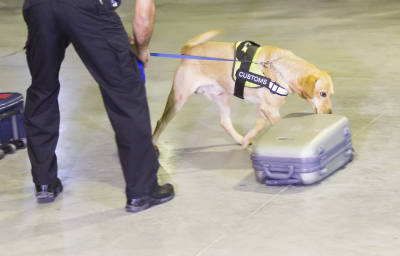
After five women form Bogota, Colombia, aroused suspicion at London’s Heathrow Airport in 1988, sniffer dogs were brought in to examine their luggage. The dogs led customs men to 20 LP records in each of the women’s suitcases. When the vinyl layers of the records were split open, cocaine was discovered sandwiched between the halves. A total of 16 kilos of the drug was found in the records and in the jackets of books. The women were all jailed for 14 years.
Sniffer dogs are used by police and customs throughout the world to detect drugs and explosives.
Dogs that are trained for the job include natural retrievers used in filed sports, such as Labradors, collies and spaniels. Dogs have a far better sense of smell than people because the smell receptors at the top of a dog’s nose are 100 times longer than in humans.
The training course for a sniffer dog normally lasts about 12 weeks. The dog is first taught to recognize a particular drug or explosive.
Its handler conceals a sample of the substance inside something the dog can grip in its mouth – a rolled-up newspaper, a piece of pipe or a rag – which is known as a training aid.
The dog is commanded to bring the aid back to the handler, and then receives a reward. The reward will be whatever that particular dog enjoys doing – usually a friendly fight with the handler or a game of hide-and-seek.
The dog learns to recognize the smell of the training aid, which is in fact the smell of the drug or explosive. The type of training aid is changed regularly, but the smell always remains the same. At fist the aid is placed within sight of the dog, but is then hidden out of sight.
Smells such as perfumes, which some smugglers spread to disguise the scent of drugs, are also used so that the dog becomes familiar with them.
A dog can eventually be trained to respond to up to 12 different types of explosives and four different types of drugs, usually cannabis, cocaine, heroin and amphetamine.
When a dog is sent out to search for drugs, perhaps in a lorry or warehouse, it is put into a special harness – a signal that it should start working. When it locates a smell which it knows will lead to a reward, it will become agitated and excited.
Other customs or police officers then take over.
The handler drops a training aid where the dog will see it and return it, and the dog then gets its reward.
Air samples
Machines that are used to detect drugs and explosives suck in air through a tube that can be inserted into concealed spaces such as petrol tanks, paneling in vehicles or gaps between walls.
They also take air samples from containers and lorries where drugs and explosives might be hidden.
The samples are analyzed by a machine called a mass spectrometer which breaks them down into their chemical parts and identifies minute traces of individual substances used in explosives or drugs.
It is claimed that traces as small as one-trillionth of a gram can be detected.
Electron movement
‘Sniffer’ machines large enough for people to walk through have been installed at the Houses of Parliament in London and at some international airports, including Seoul before the 1988 Olympic Games. They can detect dynamite or nitroglycerine, which gives off a vapour that attracts electrons. A current running through the sniffer machine detects the movement of the electrons.
Picture Credit : Google

